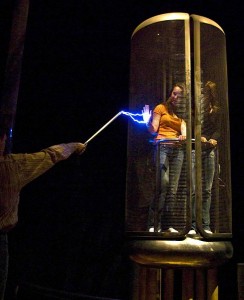Survive: Buying a Ready-Made Faraday Cage?
You know when people say that store bought isn’t as good as home made? That’s all well and good, but does that go for Faraday cages? Even though we’ve covered Faraday Cages a couple of times before, we still get questions about them pretty often. As awareness about EM (electromagnetic) fields and radiation grows, that’s only going to increase, and so we’ve decided to take a look at whether buying a ready made Faraday cage is better than making one yourself. Because it’s very much possible to do both.
First, I thought it would be a good idea to actually look at what a good, old fashioned Faraday cage can do for you! Yes, you. Everyone should have one of these bad boys.
What is it, and what does it do?
A Faraday cage is basically a box of a sort, that leads the charge from an electromagnetic pulse or radiation around what’s inside and down to ground.

This means that anything inside the box will be protected from the EMP emissions of a nuclear detonation for example, which could come in handy if the Soviets decide to rise again. Which they surely will. Or the Nazis, perhaps. That’d be fun, wouldn’t it?
There’s a lot of writing out there about Faraday cages, and even a couple of mythbuster episodes, but what will actually work? There’s a few things that you have to remember in order to get a real, working Faraday cage.
1) It needs to be made of a metal, conductive mesh. That’s copper to you, son.
2) It has to be grounded. That means, to get the best protection possible, sticking a copper rod, connected to the cage, in the ground. Literally.
3) Any connections to the outside world (like power for that battery charger, your HAM radio and that computer) needs to pass through EM filters. If they don’t, then it’s like building a roof to protect you from the rain, then putting a giant hole in it.
Faraday Bags
If you’ve ever tried to put together your own computer, or you’ve bought stuff for inside your PC, then you’ve seen those funky plastic bags those parts come in, right? Right. Basically, those things conduct static electricity around the outside of the bag, so that the stuff inside can’t be broken by it. Now, I know what you’re going to say; static charges aren’t at all like EMPs. But that’s not strictly true. EMPs will damage electronics in the same way as an EMP; by sending uncontrolled charges through the circuitry. Which is bad.
That’s why a “faraday bag” can, to some extent, protect your stuff in case you get hit by an EMP while you’re on the go. Check this out, for example:

This is an 8″ x 10″ bag made for electronic circuitry, but can easily hold other stuff – how about your 2-way radio, a cell phone or other communications gear? That’d be nice to have in a pinch.
The main problem with a faraday bag is that it isn’t grounded, and so it wouldn’t provide you with any serious level of protection against an actual EM Pulse. That’s why you should always ground such a bag to yourself (sounds dangerous, but isn’t) when you can, by using a wire and a clip. Those things can be bought at any computer store, and cost next to nothing. A larger Faraday cage needs other grounding, of course.
Full Blown Faraday Cages
Building your own (or having a contractor do it) Faraday Cage in your home is a very good idea. That means turning a room in your house into a Faraday cage, not the whole thing, because that would be both expensive and silly, even though there are in fact people who do it…

Since we’re mainly going to address buying Faraday cages here, it should be said that if you decide to hire a contractor to do this, make sure they have some experience, or at least education, in how to do this kind of work. It’s going to be time consuming, and if they don’t get it right, then it would all have been for nothing.
There are several specialized companies out there who can turn your room, or your house if you prefer that, into a working Faraday cage, such as this one, or this, or this, but it all comes down to the same thing: the materials need to be right, the grounding needs to be right, and you have to be able to actually use the room for other things when there’s no overhanging danger of an EMP coming your way. Also, there will be electrical work required, perhaps even plumbing, so you have to get someone who’s licensed for that kind of thing to do the job for you. Unless you’re an electrician, do not attempt electrical work yourself. You’ll end up either electrocuting yourself or setting fire to your house. Perhaps even the neighbor’s house. And his cat.
Before You Buy
– Decide which room you want converted to a Faraday Cage. Calculate the amount of metal mesh you’ll need; this will account for much of the cost.
– Make some inquiries. Will it pay to buy the mesh and materials yourself, and then hire someone for work only?
– Ensure that you have access to good (not just adequate) grounding. Water pipes won’t do it – you need to ground this thing like a lightning rod.
– Shop around. There’s bound to be several companies in your area that can do the job; check both their prices and their references. It pays.
– Plan out the cage before you ask for a quote. How many sockets, what kind of plumbing (if any), and what kind of grounding you’ve got available. remember that grounding wires can travel through your walls to the outside, and probably should, but that’s additional work. Placing the cage in your basement requires only straight down drilling…
After it’s Done
Test it. Try and make a call from inside the cage on your cell phone (shouldn’t be possible), test your sockets (these should be safe even in a thunderstorm, people!), and if you find any discrepancies, get on the phone to that contractor right away. After all, who knows when the zombies might get here, right?

I want to install a faraday cage over my emergency whole house 15k generator…What would I need and is it possible that someone/company would or could make a simple cage to straddle the generator? this is wired to 200 Amp box, propane powered and is approx. 48x36x 36…
Thanks,
Dale Alumbaugh
d.alumbaugh@yahoo.com
Hi Dale.
I think you need to look at the workings of a Faraday cage a little closer. It is there to block the surge of electromagnetic energy that an EMP is, and therefore, the cage needs to encase the item, not straddle it. Also, EMP surges will travel down cables, so it you want to protect your generator, you will need to make sure it is separated physically from the outside when the EMP hits.
Now, there’s also another point to consider; is the generator actually vulnerable? Remember that an EMP will not harm the mechanical workings of an engine, it will harm the electronics that control an engine. I.e. an old-fashioned (though not necessarily old) engine without computers and electronic controls will still work absolutely fine after an EMP.
Our advice is to either shield your entire shelter/hideout, use an engine/generator without electronic controls (which is risky) or to physically separate the generator from the environment when it is not used – then connect it when the EMP has passed and there is no risk of another one.
Did that answer your question, sort of?
If i remember correctly it was the americans snake that detonate not one but two atomic bombs over 2 populated cities not the russians or the nazist. You have a washed-out brain dude.
I simply couldn’t depart your site prior to suggesting that I really enjoyed the usual information an
individual supply in your visitors? Is gonna be again steadily in order to investigate
cross-check new posts